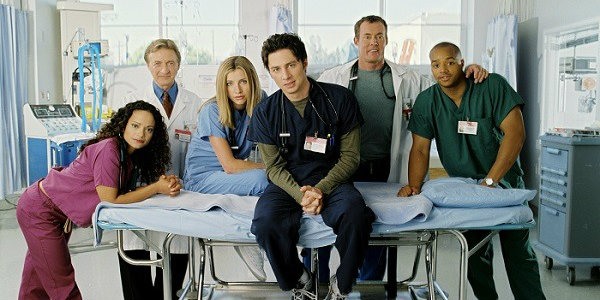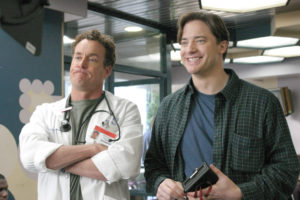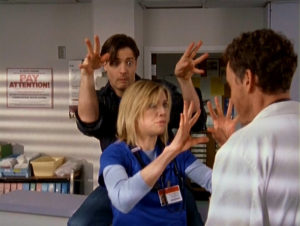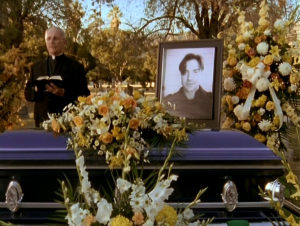
Lenten Stories: There, But Not There
The death of a cherished friend or family member is truly an experience that is beyond description. Have you ever attempted to articulate the grief you feel at such a loss to someone who has never experienced it? All words fall short.
It seems fitting, then, that God created in humanity a desire and drive for creative expression. Art of all sorts is what offers us a medium to express the inexpressible. If we want to begin to grasp the pain of losing a loved one to death, especially an unexpected death, art is where we do so. And it is through art we best explore our own mortality, conjuring images, sculptures, lyrics, and measures of music to give representation to that which is far beyond our understanding.
Hence, my Lenten Storybook. It is a growing collection of narratives from various mediums which are meant to help us reflect, meditate on, and even battle with our mortality and the memory of dead loved ones.
When a loved one dies, we are forced to face our mortality. I think this is no better illustrated than in an episode of the television series, Scrubs.
For the uninitiated, Scrubs follows the lives of various staff members of Sacred Heart Memorial Hospital. The season 3 episode, “My Screw Up” (S3E14) features the return of Dr. Cox’s ex-brother-in-law and best friend, Ben, played by Brendan Fraser. Ben made his first appearance in season 1. In the season 1 two-part episode, Ben is

introduced as a goofy Brendan Fraser-type, always taking pictures with his Polaroid camera, who is diagnosed with leukemia. Skip ahead two seasons, Ben is back in town for the birthday party of Cox’s son, and is in remission. (Spoilers ahead).
When Ben tells Dr. Cox that he has not been receiving regular checkups, Cox tells the show’s lead character J.D. to run
some tests on Ben. J.D. protests as he is working with another patient who has an irregular heartbeat. When Dr. Cox returns, J.D. tells him he lost the patient to cardiac arrest. Cox is furious with J.D. and sends him home. Dr. Cox spends the rest of the day being followed around by Ben, who adds commentary and tells Cox that it isn’t J.D.’s fault. In the background, preparations for the birthday party are looming. After working 60 straight hours at the hospital, Ben convinces Cox to go to the party and apologize to J.D. It is only as Ben and Dr. Cox arrive that J.D. asks Cox “Where do you think we are?” Ben disappears and the viewer realizes that Ben was the patient who died, and J.D. and Dr. Cox are attending his funeral, not a birthday party.
Perhaps the most powerful and understated narrative device in this episode is Ben’s Polaroid camera. It is with him at the episode’s beginning. He’s taking candids any chance he gets. But when he reappears after J.D. has told Cox he lost the patient (Ben), the camera has disappeared. The one item through which Ben engaged the physical world is gone. It’s subtle, and is a detail I only caught on my fourth viewing. I think that it is no coincidence that the object associated  with Ben is one that captures memories and stills of history. Yet, when Ben was no longer around to memorialize the moments, Dr. Cox held on to his presence the most.
with Ben is one that captures memories and stills of history. Yet, when Ben was no longer around to memorialize the moments, Dr. Cox held on to his presence the most.
“My Screw Up” is one of the best episodes ever produced in the series, and it is in no small part because the viewer is never made aware that Ben has died. He engages with Ben as he would any other character. Yet Cox is aware, because he never interacts with Ben in the presence of anyone else.
Cox’s interactions with Ben are similar to how one might interact with the photograph of a dead loved one. He converses with him, imagines responses, and even attributes a certain moral compass to his deceased best friend.
I find that when a loved one near me dies, his or her memory occupies this weird space of “there, but not there.” I instinctively expect to see him or her in the usual places. I periodically can still recall his or her voice with near perfect clarity.
Shortly before Ash Wednesday this year, a friend of mine took her own life. She was in her early twenties, an astounding visual artist with a style all her own, and was a joy to be around. Such an unexpected tragedy stirs up far  too many questions, most of which boil down to “Why?”
too many questions, most of which boil down to “Why?”
I’m on the road a lot. My small car is where I do much thinking, sometimes too much thinking, and sometimes out loud. In the days after my friend’s death was announced, I often envisioned her in the passenger seat of my car, and I would ask her questions. I imagined her answers. There was nothing concretely gained by this activity, but as someone with an imagination that takes on a life of its own, it became part of my grieving process.
Perhaps some of you have handled death the same way. Maybe it has taken a picture or a headstone to encourage you to speak. Like Dr. Cox, we have a desire to speak with the dead, to resist the notion that material life comes to an end, even if only for a time.
The space for grieving, the space for lament, the space that Lent lends itself to, lead us into a place of willingly embracing that which is there, but not there.
Peace.